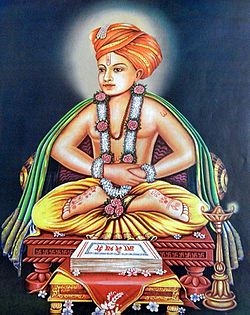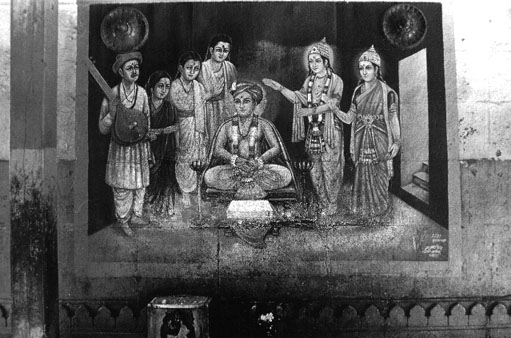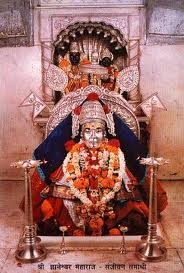
Jnanadev (also known as Jnaneshwar or Dnyaneshwar or Dnyandev (1275–1296) was a 13th-century Marathi saint, poet, philosopher and yogi of the Nath tradition whose Jnaneshvari (a commentary on the Bhagavad Gita) and Amrutanubhav are considered to be milestones in Marathi literature. Jnanadeva lived during the rule of King Ramadevarao, immediately prior to the Moghul invasions, for an all too brief 22 years and left a rich body of spiritual writings. He is honoured to this day in Alandi, his place of internment.
Introduction
Jnanadeva of Maharashtra lived late in the Eleventh Century during the rule of King Ramadevarao, immediately prior to the Moghul invasions, for an all too brief 22 years and left a rich body of spiritual writings [Amritanubhava, the Abhangas, the Jnanesvari and the Changadeva Pasashti].

Biographical details are sketchy. It seems Jnanadeva lived approximately 1275 to 1296. Some scholars allege some attributed works are written by two different persons of the same name; there are two tombs [or Samadhi] in existence for Jnanadeva, which further confuses historical data. Jnanadeva translated the Bhagavad Gita into Marathi and provided a magnificent commentary that is richly illustrated with idiom, metaphor, simile and homely example. His principal work, the Jnanesvari (alt. Jnaneshwari) was named Bhavartha Deepika (Light on the Inner Meaning); however it goes by the name “the Jnanesvari” in honour of his name, Jnanadeva. His works charged the entire region of Maharashtra with devotion and wisdom.
Jnanadeva inspired other saints that followed him – Namadeva, the tailor’s son, Narahari, the goldsmith, Gora the potter, Chokamela and his wife, who were from a very low caste and Janabai, the maid servant, and so on. He was the pioneer of the Abhanga tradition, and of the Varkari tradition, the annual pilgrimage to the sacred Vittal Mandir of Pandaripur.
Ancestors
Jnanadeva has one well known ancestor, Trimbakpant, who was made provincial Governor of Bida in 1207; another ancestor, Haripant, son of Trimbakpant, was made captain of the army in 1213. Jnanadeva descends from another son of Trimbakpant, Govindpant. Jnanadeva’s father was son of this Govindpant. His father was one Vitthalpant who inherited the kulkarni position (local accountant) of his home town Apegaon, a village situated on the northern bank of the River Godavari. He was married to Rukhamabai, the daughter of Sidophant, who was the kalkarni (mayor, civic leader) of Alandi. After the death of Govindpant, it seems Vitthalpant was generally disaffected and disgusted with life; and further disgusted with marriage, as he was unable to beget progeny. He was invited by his father-in-law, Sidophant to come and live with him, only after he had begotten progeny by his wife.
One day, with the consent of his wife, he left home and family to live in Benares. He took orders and was initiated into sanyas by Ramananda or one of his disciples. Namadeva (another saint) tells of one man who was called Vitthalpant whom later became a householder. As time came to pass, Vitthalpant’s spiritual teacher Ramananda was travelling from place to place during his southern pilgrimages, and alighted at Vittalpant’s home town. He had a meeting with Siddesvarapant and Rakhumabai, who were pining after the loss of Vitthalpant, and he was moved by their heart felt supplications, and, after realising that Vitthalpant was one whom he had initiated into Sanyas and had left behind a wife to support, immediately promised to send Vitthalpant back as soon as he returned to Benares (Varanasi).
Accordingly, when Ramananda got back to Kasi, he admonished Vitthalpant and insisted upon his disciple returning to his wife. It was not proper, he told, to take sanyas without the consent of the wife and before she bore him a child. Vitthalpant had to obey his guru and returned to Alandi to join his wife.
Father returns to the Domestic Life
Vitthalpant went back and shocked the whole community by resuming his married life (In India, once a person becomes a sanyasin (surrendered all ties to family and community), one can not resume the material life under any circumstances). The local orthodox community did not take kindly to Vitthalpant returning and excommunicated the couple. They had four children in quick succession. Jnaneshvar (hereafter referred as Jnanadeva) was the second child. The eldest was Nivritti and Sopana was the third male child. The last child was his sister, Mukti. One may appreciate the names: nivritti (control of the senses), and jnana (wisdom) are sopana (the ladder) for attaining mukti (liberation, freedom from the cycle of birth-rebirth).
Jnanadeva and his siblings were progeny of a renunciate turned householder, a situation that brought them constant calumny from an orthodox society. All of the family were ostracised from the community and lived in a small hut. At the age of seven/eight, Nivritti had to be invested with the sacred thread to become a Brahmin. However, no one in Alandi was even willing to look at the children, let alone perform ceremonies for them. Therefore, Vitthalpant moved his family to Nasik, and the whole family used to circumambulate the hill from which the holy river Godavari originates. One finds the river originates drop by drop, and passes through a linga at the bottom of the hill before becoming a full fledged river. They circumambulated the hill to expiate their sins. However, one day, as fate would have it, a tiger attacked the family during the circumambulations. After everyone had run away, Nivritti got separated from the family. He took refuge in a cave where he met Gahininatha, the fourth in the Natha lineage who initiated him. However, the problem of the sacred thread ceremony remained and the family returned to Alandi. Social persecution continued.
A Legend of the boy Jnanadeva

After the unexpected death of both their parents, the children decided to go to Paithan (Pratisthanapana) which was then regarded as a centre of learning and sastric authority in those times, and obtain a certificate of suddhi (purity). One popular legend relates the following tale: The pundits at Paithan took pity on the four small children, but still could not decide to issue the certificate of purity since there was no precedent in the scriptures.
A Brahmin decided to make fun of the children and asked the meaning of their names. Jnanadeva replied that his name signified Jnana, to which the Brahmin retorted that the buffalo on the road was also named Jnana. Jnanadeva replied that the essence of the buffalo and himself were not different. Irritated by this, the Brahmin took a whip and flung it at the buffalo. When the whip hit the buffalo, it left scars on Jnanadeva, a young child of seven. The crowd of pundits were astonished at this. Jnanadeva went to the buffalo and asked it to recite a verse from the Vedas to prove that the essence of the buffalo and himself were not different. Lo and Behold, the buffalo spoke! All the Brahmins and pundits prostrated at the feet of Jnanadeva.
After obtaining the certificate of suddhi, (purity) Jnanadeva returned along with his brothers and sister and went to Nevase, where, with his spiritual power, he saved Sachidananda Baba from a dangerous illness. This rescue filled Sachidananda Baba with profound gratitude. He became a very willing amanuensis (scribe) to Jnanadeva for the writing of Jnanadeva’s work. The four great works of Jnanadeva are the Jnanesvari, (an exposition on the Bhagavad Gita), the Amritanubhava, the Abhangs, (spiritual poetry) and the Changadeva Pasashti (a story of conversion from hatha yoga to the spiritual life).
The Scribe Begins
The Jnanesvari was written in 1290, with Sachidananda Baba as scribe, and was handed down in manuscript from generation to generation. In 1590, Ekanatha undertook to prepare a correct text of the Jnanesvari, because, “even though the work was extremely accurate originally, still it had become spoilt by changes of reading, during the interim”. It seems that Ekanatha did not tamper with the text; he substituted correct readings for the local patois, and rounded the number of verses to 9000.
Devotion to the Guru
Jnanadeva was possessed with devotion to the Guru and gives vent to his feelings in the Jnanesvari from time to time. He speaks of the master having enabled him to cross the ocean of existence. He cannot adequately praise the Guru. Is it possible to add lustre to the Sun? Is it possible to crown the Kalpatru with flowers? Is it possible to add a scent to camphor? How can a sandalwood tree be made more fragrant? How can one give hue to a pearl? Or what is the propriety of giving a silver polish to gold? It is better that one should remain silent and bow at the feet of the master. When the sun shines, the moon fades in the background; when the Guru shines, all the sciences fade away. Thus, the only adequate way of expressing one’s appreciation of the greatness of the Guru is to submit in silence to the feet of the Guru, for the greatness of the Guru can never be adequately praised. “Let me make my heart the seat for the Guru, a handful of flowers of praise. Let me apply to the feet of the Guru a finger-full of sandalwood ointment, made pure by the consideration of identity … Let me put upon his feet ornaments of spiritual gold, Let me place upon them the eight-petalled flower of pure joy. Let be burn the essence of egoism, wave the lights of self-annihilation , and cling to the feet of the Guru with the feeling of absorption.” (XV, 1-7)
The Jnanesvari, being essentially an expositional work, follows the metaphysical lines laid down in its prototype, the Bhagavad Gita. As the relation between the Prakriti (nature, created world) and the Purusha (The Supreme Being, God), forms one of the most important items in the Bhagavad Gita. This also forms the foundation stone of the metaphysics of the Jnanesvari. Jnanadeva reverts from time to time to the description of the Prakriti and the Purusha. In the ninth Chapter, he tells us how Atma (Soul) is the eternal spectator (or witness) while Prakriti (nature) is the uniform actor. It is said, says Jnanadeva, that a town is built by a king; but does it forthwith follow that the king has constructed it with his own hands? As the subjects of a town follow each his own profession, being all presided over by the king, similarly, the Prakriti does everything and stands in the background. When the full moon shines on the horizon, the ocean experiences a great flood; but does it follow from this that the moon is put to any trouble? A piece of iron moves merely on account of the vicinity of a magnet; but the magnet itself does not suffer action … … As a lamp, placed in a corner, is the cause neither of action nor of non-action, similarly, I am the eternal spectator, while the beings follow each its own course (IX. 1010-1029).

Crossing The Ocean of Life described
In a sustained metaphor, Jnanadeva describes how it is possible for a spiritual aspirant to cross the flood of unreality. The stream of maya (illusion) issuing out of the mountain of Brahman first shapes itself in the form of the elements. Then on account of the heavy showers of the qualities, the stream experiences a flood and carries off the streamlets of unrestrained virtues. In the flood there are whirlpools of hate and circles of jealousy. In it, huge fishes in the shape of errors swim to and fro. On the island of sexual enjoyment are thrown over waves of passion and there are many creatures appear to have come together. There are scarcely any pathways through that great water; and it seems impossible that the flood may ever be crossed.
Is it not wonderful, asks Jnanadeva, that every attempt that is made for crossing this flood becomes only a hindrance in the path of crossing it? Those, who are dependent upon their own intellects, try to swim over this flood and no trace of them remains. Those who are given to over-self-consciousness, sink in the abyss of pride. Those, who try to cross this flood by means of the knowledge of the Vedas, hug to their heart huge pieces of stone, and go entirely into the mouth of the whale of arrogance. Those, who clasp the chest of sacrifice, go only into the recesses of heaven, where no boat of dispassion is available where no raft of discrimination is to be found, where whatever else may be done becomes a hindrance.
If the young one of a deer were to gnaw at a snare, or an ant to cross over the Meru (ocean), only then would people cross this stream of maya (illusion). It is only those who are full of devotion to me, for whom the Guru acts as a steersman, and who take recourse to the raft of self-realisation, for such we may say the flood of illusion ceases to exist even before they try to cross it. So Jnanadeva introduces the central point of his great work – devotion to God.
Jnanadeva addresses many and various doctrines contained in the Bhagavad Gita, the transmigration of souls, reincarnation as illusion, the origin, being and end of the Asvattha Tree (the tree of existence). Images and idols do not contain the reality of God, for God cannot be known in His entirety. Jnanadeva then uses the descriptive mode to go through a catalogue of vices and virtues, enumerating unpretentiousness, harmlessness, sufferance and straightforwardness, devotion to Guru, purity, steadfastness, self-control, dispassion, absence of ego, pessimism, detachment and love of solitude, together with God devotion. Jnanadeva proceeds to discuss the two heritages of man, divine heritage and demonic heritage. The divine heritage is a heritage of virtues; the demonic heritage is a heritage of vices. Jnanadeva tells us the first heritage is fearlessness. After enumerating many classes of heritage, along with the nature of sacrifice, energetic penance, dull, lazy penance, and serene penance, the nature and fruits of active, dull and serene sacrifices are then accounted. Action, works, and realisation are then mooted.
Jnanadeva says action should lead to self-realization. Various means are suggested. The first means suggested for riddance from action is the habit of doing our actions, because duty impels us to do them. The consideration of duty, therefore, forms the first justification for action. God Himself prescribes social duty, and this duty was divided according to the requirements of castes and orders. “Do your duty and the end will take care of itself. Do not go in for any vows or ceremonies. Trouble not yourself by going to places of pilgrimage. Do not deliver yourself to means like yoga, or to targeted worship, or to charms and incantations. Worship not other deities. Do the sacrifice implied in your duty. Worship your deity with a mind bereft of any consideration of consequences, as a chaste woman worships her Lord …. if you just follow your duty, then duty will be a wish-fulfilling cow for you.” Thus the proper and correct performance of duty is the first way out of the bondage of actions.
The Goal and the Journeyman
Following the structure of the Bhagavad Gita, Jnanadeva continues to describe the temperaments of man and their impacts on the spiritual life. He graphically describes the lure of desires, the uprooting of the “tree of unreality”, the destruction of the moral vices and the pathway to God. In a attractive analogy, he speaks of “where the travellers [on the pathway to God] place their footprints, the mine of absolution opens of itself. Even in one goes sideways off this path, one goes to heaven. Starting from the east one does necessarily go to the west; in this determinate fashion is the journey of the path. While the wonder of it is, that as one travels on this path towards the goal, one becomes the goal itself.”
Light seems to be one of the chief forms in which God reveals himself. Jnanadeva says, “That which is older than the sky, and which is smaller than the atom; by whose presence the whole world moves; that which gives birth to everything; that by which the world lives; that which surpasses all contemplation; that which even by daylight is as darkness to the physical eye, as the white ant cannot gnaw into fire nor can darkness enter into light; that on the other hand which is as eternal day to the knower; that which contains an infinitude of light-rays, and which knows no setting” [VIII, 87-90]. This seems to be the description of enlightenment known by Jnanadeva.
Jnanadeva also tells us that God is like a beacon-light of camphor which moves onwards to show the way to the seeking mystic, and which, after the destruction of the darkness of ignorance, shines as eternal day. In the same way, he tells us of the infinite lustre of the atma (soul). “The lustre of the body of God was simply indescribable. It was like the combining of the lights of twelve suns at the time of the great conflagration. The thousand celestial suns that rise as one in the sky, could not have matched the infinite lustre of the atma. Had all the lightnings been brought together, had all the fires at the time of the Great End been mingled together, had all the ten great lights been fused into one, it would have been impossible for them to compare with the lustre of the great God. Thus was the greatness of God’s light. His lustre shone all around, and I saw it by the grace of the Sage“. [XI, 237-241]

Words of a realised person?
There is speculation that Jnanadeva was a realised person, and it would seem to be speculation with a reasonable foundation. Jnanadeva chose the time of his death and followed the sastric authorities in the manner and mode of leaving his body. In the Jnanesvari, Jnanadeva describes in succession the bodily effects of God realisation, the mental effects of God realisation and the moral effects of God realisation. Jnanadeva goes on to describe the ideal sage as one without joy, one without sorrow, always full in the knowledge of the self. The Jnanesvari continues, giving the marks of the man who has reached identity with God. Such a devotee has single pointed devotion:
What is now one-pointed devotion? … As the lustre of the jewel is the jewel itself, as the liquidity of water is water, as space is the sky, as sweetness is sugar, as consolidated ice is the Himalayan mountain, as congealed milk is curds, similarly, the whole world is Myself. Do not, therefore, deny the world to find Me. I include the whole world in Me. Experience such as this means one-pointed devotion, and My devotee has got this one-pointed devotion” (XIV. 372 -382).
“As a particle of gold becomes one with gold, as a ray of light merges in light, as pieces of ice constitute the Himalayan mountain, similarly, the individual selves make God. The waves may be small, and yet they are one with the ocean… Experience, such as this, is real devotion” (XIV. 383-388).
“This is the acme of all knowledge. This is the goal of all yoga: as deep may call unto deep, and the two may be connected by incessant showers; as the image may become one with the original by the contact of light; similarly, the Self is connected with God … Fire ceases after having burnt the fuel, similarly) knowledge ceases by having destroyed itself. I am not on one side of the ocean and the devotee on the other. There is a beginningless unity between us … He who knows this is verily the crest-jewel of those who know” (XIV. 389-401).
Jnanadeva continues with insight into the physical and psychological effects of God-realisation. There is a description of the 8 pure emotions of realisation:
- a. Duality ceases
- b. Mind becomes composed
- c. Internally a feeling of joy
- d. Strength fades from limbs
- e. Horripilation from top to toe
- f. Drops of sweat form on the body involuntarily
- g. Shaking with bliss
- h. Uncontrollable tears of joy
These are also known as the sathwic (pure) emotions. Jnanadeva declares “rare is the one who reaches the end”; “who has the resolve to do this?” and “who actually achieves this”? The path to god realisation is slow and steady. When the sun rises, it is not immediately at its zenith; so too, when one begins on the path to realization, one does not immediately reach the goal. It ascends slowly and steadily. Jnanadeva exhorts:
- – The true path is known
- – The company of the good and the godly
- – When dispassion has been generated
- – Perfection is attained gradually
- – God is the sole object of the saint
- – The devotee is nearer to the heart of God than anybody else
- – The office of God is always the welfare of the devotee.
Jnanadeva tells us again in another passage that the Lord’s devotees need never entertain any anxiety for their material and spiritual welfare.
“They are doing duties that are proper for them according to their caste. They obey the law, and discard every thing that is not sanctioned by morality. They deliver their actions to Me, and thus burn their results … … The goal of all their bodily, mental, and verbal activity, is I Myself … … They are meditating on My form … … With one-pointed devotion, they have sold their mind and body to Me. Tell Me, O Arjuna, what shall I not do for them? … … Is it possible that My devotees be ever troubled by any anxiety for their worldly life? Does the wife of a prince go begging alms?’ (XII. 76- 85.)

Merger with God whilst still living
Jnanadeva goes on to illustrate the boons of the single-pointed devotee of God: God accepts the offerings of the devotee, however so humble, God endows his devotee with the highest good, that is, spiritual good; God graces devotees at the time of death and union of devotee and God is the culmination of the mystic life. Jnanadeva then proceeds to describe liberation before death, the absolute identity of the saint and God even before the saint departs this life:
“The Saint has refused to identify himself with the body, and therefore he feels no pangs of separation from it when he wants to throw it away; it does not follow that he reaches Me only after he has thrown off his mortal coil; for he has been already during his life merged in My Being He has known his Self as mere moonlight, existing not in itself, but in the moon of Universal Spirit. By having been one with Me in life, after death he also becomes Myself ” (VIII. 136-139).
“Those who, during life, have worshipped the gods, after death become gods. ‘Those who worship the fathers, merge into the being of the fathers. Those who with motives of sorcery run after minor deities, when death lets down the curtain, merge into these elementals. Those, on the other hand, who see Me with their eyes and hear Me with their ears and think of Me with their minds, who by every limb make salutation to Me, whose merit and charity are done only for My sake, who have Me as their constant object of study, who are filled with My presence in and out, who regard their life as useful only for the attainment of God, who pride themselves upon being the servants of God, whose passion is only the love of God, whose only desire and love are the desire and love of God, who are infatuated by Me, (whose sciences make Me the object of their study) whose chants are the chants of God, who in this way make Me the object of all their activities, these, even before death, have already come into My Being. How after death, shall they ever pass out of Me?’ (IX. 355-365.)
In this way, we see the absolute identity of the Saint and God even during the lifetime of the Saint.
Jnanadeva has illuminated with his metaphor, simile and homely example a practical way for the attainment of vision of God. One is to fill the inside and the outside with divine activity. One may regard God as all encompassing. The tale of union with God and the aspiring for union brings about that union.
Jnanadeva wrote a number of Abhangs in which he exhorted the knowledge of God is devotion; the realisation of God is the end of knowledge. Jnanadeva continues illumination and direct imagery:~
“As a crane falsely meditates, its object of desire being a fish, similarly, we falsely take resort to penance in a forest, when we are thinking about a woman. There is no use lashing the body until we have conquered the mind. This can only be relieved under the tutelage of a Guru”.
The entire progress in the mystic life is due the grace of the Guru. Jnanadeva’s Divine experience was vivid … he told of the abode of God with rich imagery: “a thousand petalled cavity in the brain, which is the source of all bliss. One sees the red, the white, the blue and the yellow colours, and sees these with a pure vision, I need not tell you much”. (Abg. 45) “One sees the black, the blue, and the tawny colours…. now let the colour remain firmly in the mind…. In the eye, one is able to see pure light, and one can see it even while living in the body. (Abg.46) The dark blue colour is very much insisted upon by Jnanadeva for the Divine Supreme Absolute.
God is Light, Atma is Light
Jnanadeva went on to say that the whole world is filled by incomparable light … the dawn breaks, and the light of the Sun spreads forth … by the spiritual instruction of Nivritti [Jnanadeva’s brother and his Guru], Jnanadeva has attained to spiritual wisdom … even the Sun’s light is inferior to the light of the Atman. In God, indeed, there is neither day nor night. Beyond all duality Jnanadeva has seen the eye, and nothing can stand in comparison to it. (Abg 70) God is indeed seen in the super conscious state – his light is greater than the light of the Moon and the Sun … this Self experience is known only to those who have learned it from their spiritual masters. “The light is indeed seen in the thousand petalled lotus where there is neither name nor form”. (Abg 68)
The final experience of the Self
What is this Self-vision of which Jnanadeva speaks? Jnanadeva characterises it in various different formula. “I have seen the God unobtainable by the Yogins,” he says, “and my heart’s desire is not satisfied, even though I have been seeing Him for all time. I have seen the God of Gods. My doubt is at an end. Duality has disappeared. I have indeed seen God in various forms and under various descriptions” (Abg. 77).
Contrasted with this attitude of assurance, is also the attitude of submission to the Divine will. Jnanadeva is aware that God’s nature cannot be entirely understood. ‘The cool south wind cannot be made to drop like water from a piece of cloth. The fragrance of flowers cannot be tied by a string. The Lord of all can neither be called great nor small. Who can know His nature? The lustre of pearls cannot be made to fill a pitcher of water. The sky cannot be enveloped. The pupil in the eye cannot be separated from the eye… The quarrel between God and his spouse cannot be made up. Hence, Jnanadeva meekly submits to the will of God” (Abg. 83).
Samadhi (Passing) of Jnanadeva
Jnanadeva left his body voluntarily (took samadhi) in Alandi, near Poona in 1296 at the age of 22 (or age 25 by some other scholars). He took his last bath, and descended the steps into the burial-place which had been prepared for him. Sitting in the padma position and facing North, he voluntarily released his mortal coil. The slab was placed over his body quickly.
That he not only produced this Jnanesvari exposition but also other works at such a tender age stands testimonial to the greatness of this person. He himself remarks in the sixth chapter that knowledge can be brought over from the previous birth but does not mention himself as an example. That is the mark of humility, considering that he produced Jnanesvari at the age of 15 (or 19). Though the Brahmins had made fun of him as an outcast, he never ridiculed them in retaliation. Maybe he considered them to be God’s children also, or rather the same as himself.
The Jnanesvari is chanted to this day in the temples of Maharashtra.

This work recently appeared on narayanaoracle.com and is © Chris Parnell
![]()

